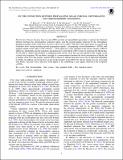Files in this item
On the connection between propagating solar coronal disturbances and chromospheric footpoints
Item metadata
| dc.contributor.author | Bryans, Paul | |
| dc.contributor.author | McIntosh, Scott W. | |
| dc.contributor.author | De Moortel, Ineke | |
| dc.contributor.author | De Pontieu, Bart | |
| dc.date.accessioned | 2016-10-03T15:30:10Z | |
| dc.date.available | 2016-10-03T15:30:10Z | |
| dc.date.issued | 2016-09 | |
| dc.identifier | 246365156 | |
| dc.identifier | 3d0faaf3-c505-4e32-b703-647cd041c0c2 | |
| dc.identifier | 84989172240 | |
| dc.identifier | 000385412000018 | |
| dc.identifier.citation | Bryans , P , McIntosh , S W , De Moortel , I & De Pontieu , B 2016 , ' On the connection between propagating solar coronal disturbances and chromospheric footpoints ' , Astrophysical Journal Letters , vol. 829 , no. 1 , L18 . https://doi.org/10.3847/2041-8205/829/1/L18 | en |
| dc.identifier.issn | 2041-8205 | |
| dc.identifier.other | ORCID: /0000-0002-1452-9330/work/39526506 | |
| dc.identifier.uri | https://hdl.handle.net/10023/9600 | |
| dc.description.abstract | The Interface Region Imaging Spectrograph (IRIS) provides an unparalleled opportunity to explore the (thermal) interface between the chromosphere, transition region, and the coronal plasma observed by the Atmospheric Imaging Assembly (AIA) of the Solar Dynamics Observatory (SDO). The SDO/AIA observations of coronal loop footpoints show strong recurring upward propagating signals—“propagating coronal disturbances” (PCDs) with apparent speeds of the order of 100–120 km/s-1. That signal has a clear signature in the slit-jaw images of IRIS in addition to identifiable spectral signatures and diagnostics in the Mg IIh (2803 Å) line. In analyzing the Mg IIh line, we are able to observe the presence of magnetoacoustic shock waves that are also present in the vicinity of the coronal loop footpoints. We see there is enough of a correspondence between the shock propagation in Mg IIh, the evolution of the Si IV line profiles, and the PCD evolution to indicate that these waves are an important ingredient for PCDs. In addition, the strong flows in the jet-like features in the IRIS Si IV slit-jaw images are also associated with PCDs, such that waves and flows both appear to be contributing to the signals observed at the footpoints of PCDs. | |
| dc.format.extent | 7 | |
| dc.format.extent | 9457746 | |
| dc.language.iso | eng | |
| dc.relation.ispartof | Astrophysical Journal Letters | en |
| dc.subject | Sun: chromosphere | en |
| dc.subject | Sun: corona | en |
| dc.subject | Sun: magnetic fields | en |
| dc.subject | Sun: transition region | en |
| dc.subject | QB Astronomy | en |
| dc.subject | QC Physics | en |
| dc.subject | 3rd-DAS | en |
| dc.subject.lcc | QB | en |
| dc.subject.lcc | QC | en |
| dc.title | On the connection between propagating solar coronal disturbances and chromospheric footpoints | en |
| dc.type | Journal item | en |
| dc.contributor.sponsor | European Research Council | en |
| dc.contributor.sponsor | Science & Technology Facilities Council | en |
| dc.contributor.sponsor | Science & Technology Facilities Council | en |
| dc.contributor.sponsor | European Commission | en |
| dc.contributor.sponsor | EPSRC | en |
| dc.contributor.institution | University of St Andrews. Applied Mathematics | en |
| dc.contributor.institution | University of St Andrews. School of Mathematics and Statistics | en |
| dc.identifier.doi | 10.3847/2041-8205/829/1/L18 | |
| dc.description.status | Peer reviewed | en |
| dc.identifier.grantnumber | 647214 | en |
| dc.identifier.grantnumber | ST/K000950/1 | en |
| dc.identifier.grantnumber | ST/N000609/1 | en |
| dc.identifier.grantnumber | 269299 | en |
| dc.identifier.grantnumber | EP/I037016/1 | en |
This item appears in the following Collection(s)
Items in the St Andrews Research Repository are protected by copyright, with all rights reserved, unless otherwise indicated.

